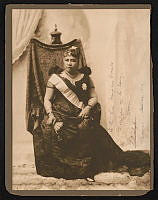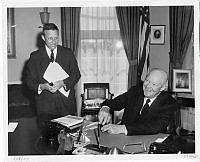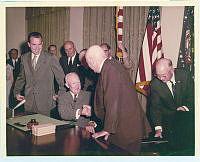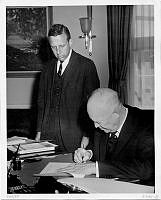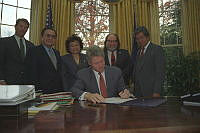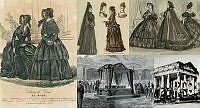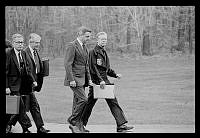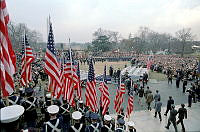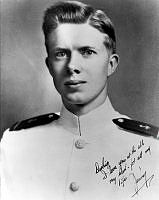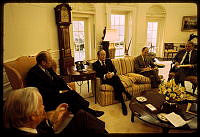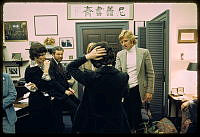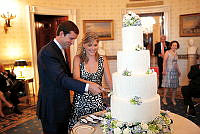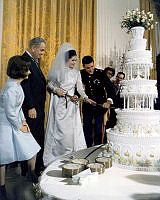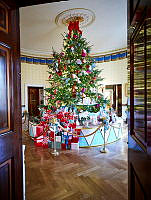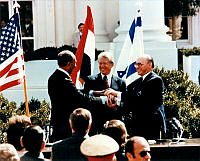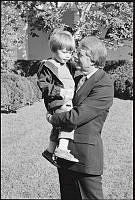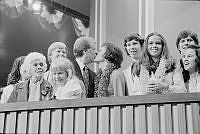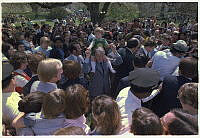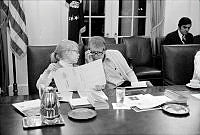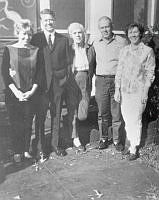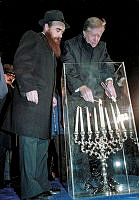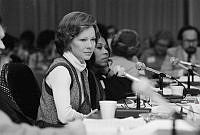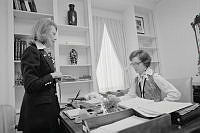Rubenstein Center Scholarship
The Life and Presidency of William Howard Taft
The White House Christmas Ornament 2012 Historical Essay
William Howard Taft was born on September 15, 1857, in Cincinnati, Ohio, to judge Alphonso Taft and his wife Louisa. He graduated from Yale, and then returned to Ohio, studied at the Cincinnati Law School, and began his law practice. He made a swift climb in politics through Republican judiciary appointments, while a seat on the Supreme Court was his ultimate ambition. His route to the White House was mapped gradually through ever more prestigious posts beginning in 1900 when President William McKinley appointed him civil governor of the Philippines. During his tenure, he improved the economy, built roads and schools, and gave the Filipino people limited participation in government. In 1907 President Theodore Roosevelt returned him to Washington to serve as secretary of war, and in 1908 he received the Republican presidential nomination. He won the election and was inaugurated in March 1909.
Taft pledged to continue Roosevelt's presidential agenda, pleasing Progressives who said that "Roosevelt has cut enough hay" and "Taft is the man to put it into the barn." Yet Taft's unexpected support of the 1909 Payne-Aldrich Tariff Act reneged on a campaign promise to lower tariffs and angered liberal Republicans. He further antagonized Progressives by upholding a decision by his secretary of the interior to sell public lands in Alaska and the Rocky Mountains. He fired Gifford Pinchot, the first chief of the U.S. Forest Service, a Roosevelt advisor and a conservationist, for insubordination in opposing the sales.
Angry politics diminished appreciation for Taft's many achievements. He signed the first tariff revision since 1897; established a postal savings system; formed the Interstate Commerce Commission; and prosecuted over 75 antitrust violations, far more than pursued by the "trust- buster" Theodore Roosevelt. The Taft era Congress submitted two Constitutional amendments to the states that were ratified in 1913: the sixteenth amendment created a federal income tax; the seventeenth amendment authorized the direct election of senators. Taft also expanded U.S. foreign trade through investment in what became known as "dollar diplomacy" increasing U.S. influence in Latin America and East Asia.
In 1912, when the Republicans re-nominated Taft, Roosevelt revolted by leading the opposing Republican Progressives (or Bull Moose Party), and thus guaranteed the election of Woodrow Wilson. At age fifty-five, free of the presidency, Taft took a position teaching law at Yale where he remained until 1921 when President Warren Harding made him chief justice of the United States. Having achieved his lifelong ambition, he held a seat on the Supreme Court until just before his death in 1930. As chief justice, his interest in civic architecture found its greatest expression when he engaged the architect Cass Gilbert to design the Supreme Court building, a white marble landmark that remains in use on Capitol Hill today.
The First Motoring Presidency
While serving as secretary of war, Taft became smitten with the White steamer, the department's car of choice. A pre-gasoline steam-powered touring car, it was manufactured by the White Sewing Company of Cleveland, Ohio, Taft's home state. Over the 1908 Christmas holidays, president-elect Taft proudly had a family photograph taken in a loaned White made into a postcard and distributed to the press. The Great Seal of the United States, painted on the door, created confusion that it was a White House automobile.
Taft believed in the future of the automobile and wanted a White when he entered the White House. After some wrangling with opponents in Congress over the costs and dangers of motorcars, he obtained a $12,000 budget for their purchase through an emergency deficiency bill. His staff negotiated a favorable price with the White Company for the steamer at $3,000, and two Pierce-Arrow limousines, a "suburban," and a landaulet, at $4,900. Taft did add the Great Seal to all of his cars allowing the fledgling automobile manufacturer the publicity of a prestigious inclusion in the first White House limousine fleet. The small remaining budget was used to convert the White House stables to a garage and pay the chauffeurs until an annual $25,000 travel expense budget went into effect in July. Taft's famous milk cow Pauline Wayne continued to be stabled at the White House until the garage and stables were demolished in 1911.
In August 1909, the Washington Post ran a feature on Taft's "daredevil" chauffeur George H. Robinson, an army civilian detailed to the White House and known for his "fast work at the wheel." It reported that the president "has the real speed fever, and Robinson knows it."
President Taft was never happier than in the back seat of his White touring car speeding through the countryside with the wind in his hair. Not required to observe speed limits or stop signs when driving the president, Robinson would blow the horn in advance of an intersection and fly through it.
The seven-passenger White was Taft's favorite of the fleet. The automobile was often tested on the paved "Speedway" in Potomac Park and along the river. Inspired by fond memories of pleasant evening carriage rides through the tree-lined streets of Manila, Mrs. Taft's support for turning this Speedway into a promenade led to the first public project ever undertaken by a first lady. She shared the idea with the president's military aide Archibald Butt and the commissioner of public buildings and grounds, Colonel Spencer Cosby. A plan was formed and Mrs. Taft selected a site for a bandstand to hold Marine Band concerts in the park on Wednesday and Saturday afternoons. Potomac Drive became an immediate success and the most fashionable place to go and be seen in Washington from April until late October. The plan to plant Japanese cherry trees along the drive also came to fruition with the help of Mrs. Taft. In 1910 Mayor Yukio Ozaki of Tokyo presented the first trees as a "memorial of national friendship between the U.S. and Japan." In March 1912, Mrs. Taft and the Iwa Chinda, wife of the Vicount Sutemi Chinda the Japanese Ambassador, planted two of more than 3,000 Yoshino cherry trees on the northern bank of the Tidal Basin, about 125 feet south of what is now Independence Avenue, where they continue to be enjoyed today.
The Taft White House
Upon taking residence at the White House, the Tafts quickly made changes in its operation, foregoing the leisurely transitions of the past. First Lady Edith Roosevelt's carriage had hardly exited the driveway when Elizabeth Jaffray arrived to assume the role of housekeeper, beginning what became seventeen years of service to four presidents. Although her abrasive, superior attitude turned the 25-member domestic staff (both black and white) against her, she had the full confidence of Mrs. Taft who was determined to end the traditional management of domestic operations by all "gentleman ushers." Since John Adams first occupied the mansion, all stewards and ushers had been men. With Mrs. Taft's blessing, Mrs. Jaffrey also ordered black servants to dine apart from white servants, thus ending an established practice of seating by rank or seniority, and beginning 50 years of racial segregation.
White House hospitality during the Taft administration featured ambitious and varied menus supervised by Mrs. Jaffrey. Formal musicales and state dinners were held on the state floor following tradition, but Mrs. Taft's elaborate parties and dances were held in the garden or on the east and west terraces, in the fashion of those she enjoyed in the Philippines.
One major change occurred to the White House complex during Taft's administration. On Taft's inaugural day, Congress approved $40,000 to double the size of the "temporary" Executive Office Building (later called the West Wing) erected during the Roosevelt administration. Nathan C. Wyeth, a Washington architect, created the first Oval office space for the president and relocated the president's office on a central axis in the building. It was fully oval, like the Blue Room. The Oval Office—as it later came to be known—took shape in the summer of 1909 and was the first new State Room since the house was built in the 1790s. The office was replaced in 1934 by the Oval Office built for Franklin D. Roosevelt in yet another major expansion of the West Wing.
Christmas at the Taft White House
The Tafts celebrated Christmas simply; they opened gifts in the morning and shared a turkey dinner later. According to press reports, a 35–40 pound prize turkey, delivered by Horace Vose, the poultry king of Rhode Island, graced the table along with "Aunt Delia's goodies." The president's Aunt Delia Torrey of Millbury, Massachusetts, always sent "Nephew Will" an eagerly anticipated package of apple pies, jellies, and jams made from fruit grown on the Torrey property.
President and Mrs. Taft enjoyed the bustle of downtown Christmas shopping with holiday crowds. On occasion the president slipped away from his Secret Service detail to stroll through the city, often with Archibald Butt. On Christmas Eve in 1911, the president and first lady secretly left the White House on foot to call on friends as a surprise. When the Secret Service discovered their absence, there was widespread panic. Chief John Wilkie and his men scurried all over town searching for them. Eventually, President Taft returned to the White House smiling broadly with Mrs. Taft holding his arm.
The Tafts were a wholesome and busy family. In 1909, their son Robert, nineteen, was a junior at Yale, and Helen, seventeen, was a student at Bryn Mawr. Only their youngest child, Charles, eleven, lived with his parents year round at the White House. The Taft children were considered too old for a Christmas tree, but in 1912 while President and Mrs. Taft were away on an inspection of the Panama Canal, Robert and Helen hosted the family celebrations and held a Christmas tree party in the Blue Room for their young cousins. The huge tree decorated with baubles, toys, and thousands of electric lights, set a precedent for decorating a tree on the State Floor for guests. Although absent, President and Mrs. Taft provided gifts for friends and each employee of the White House received a fat turkey, a practice began by presidents in the nineteenth century.
FURTHER READING:
Bromley, Michael L. William Howard Taft and the First Motoring Presidency. Jefferson: McFarland, 2003.
Bromley, Michael L. and Tome Mazza. Stretching It: The Story of the Limousine. Warrendale: SAE International, 2002.
Mannion, Hillary. "Motor Cars Come to the White House," White House History 28 (2010): 38–45.
Seale, William. The President's House: A History. Washington, D.C.: White House Historical Association, 2008.
Seale, William. The White House: The History of An American Idea. Washington, D.C.: White House Historical Association, 2002.
Taft, Helen Herron. Recollections of Full Years. New York: Dodd, Mead & Company, 1914.
HISTORIC SITES:
William Howard Taft National Historic Site. 2038 Auburn Ave. Cincinnati, Ohio 45219
Heritage Museums & Gardens. 67 Grove Street Sandwich, MA 02563
Malacañang Palace. 1000 J. P. Laurel Street San Miguel, Manila, Philippines













